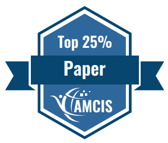Data Science and Analytics for Decision Support (SIG DSA)
Loading...
Paper Type
Complete
Paper Number
1168
Description
It is unclear the extent to which offline social networks are different from online social networks. One pervasive characteristic of offline social networks is homophily – the propensity to form ties with similar others –, which theory stipulates might be weaker as a force for tie formation in online ties relative to offline ties. In this study, we theorize that homophily will be stronger in minority groups compared to majority groups in motivating tie formation in online networks. We also theorize that network structures of business unit subnetworks will vary according to whether the business unit is internal-facing or external-facing. We test our hypothesis using data on email activity among the 2,000+ employees of a large financial services company over a three-month period. Our hypotheses are partially supported by the findings. We offer implications to theory and practice based on our findings and propose avenues for future research.
Recommended Citation
Chipidza, Wallace; Tripp, John; Akbaripourdibazar, Elmira; and Kim, TaeHoon, "Gender and Racial Homophily in Email Networks and the Moderating Role of Business Unit on Network Structure: Evidence from a Large Financial Services Company" (2021). AMCIS 2021 Proceedings. 3.
https://aisel.aisnet.org/amcis2021/data_science_decision_support/data_science_decision_support/3
Gender and Racial Homophily in Email Networks and the Moderating Role of Business Unit on Network Structure: Evidence from a Large Financial Services Company
It is unclear the extent to which offline social networks are different from online social networks. One pervasive characteristic of offline social networks is homophily – the propensity to form ties with similar others –, which theory stipulates might be weaker as a force for tie formation in online ties relative to offline ties. In this study, we theorize that homophily will be stronger in minority groups compared to majority groups in motivating tie formation in online networks. We also theorize that network structures of business unit subnetworks will vary according to whether the business unit is internal-facing or external-facing. We test our hypothesis using data on email activity among the 2,000+ employees of a large financial services company over a three-month period. Our hypotheses are partially supported by the findings. We offer implications to theory and practice based on our findings and propose avenues for future research.
When commenting on articles, please be friendly, welcoming, respectful and abide by the AIS eLibrary Discussion Thread Code of Conduct posted here.



